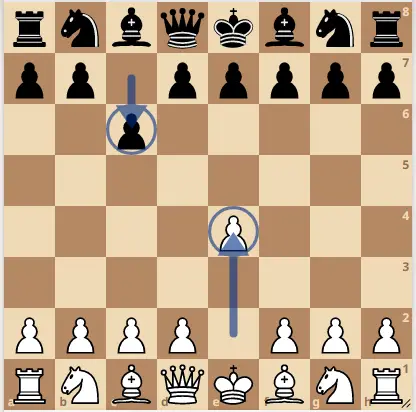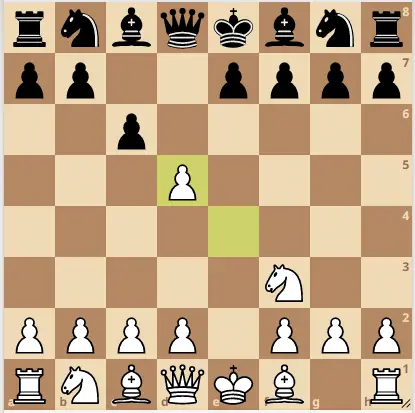The pawns are the soul of chess as they help to decide the characteristics and nature of the position. Without them, there will be no chess.
Many beginner players would like to know how the pawns move and capture over the chess board. One common question that may arise is “Can the pawn move sideways?”
In this article, we answer that question and explain some of the special moves a pawn can make over the board. Here is what you should know:
Can A Pawn Move Sideways?
A pawn cannot move sideways in chess. However, it can move one square forward or 2 squares on its first move. The only pieces that can move sideways are the rook, queen, and king. You could also say that the knight move sideways as it moves 2 squares like a rook and then one square at a right angle to form an “L” shape.
Pawn move 1 or 2 squares forward (never sideways)

The king, rook and queen can move sideways unlike the pawn

Does The Pawn Capture Sideways?
The manner at which a pawn captures a piece is different compared to when it moves forward on the chess board. One may thing that the pawn captures a piece on the square directly in front of it, but this is not how it works. The pawn actually captures a piece one square diagonally forward to the left or right.
The pawn capture diagonally forward to the left or right

After the capture

Therefore, a pawn cannot capture a piece sideways nor can it capture a piece directly in front of it. A piece that is one square in front of the pawn simply stops the pawn from advancing forward which is called a blockade in chess.
The white and black pawn in the center are stopping each other from advancing. Neither pawn can be captured by the other.

Does The Pawn Move Sideways In “En Passant”?
En passant is a special move in chess that doesn’t occur too often and can only be performed under certain conditions. However, it’s important that you become aware of this move as you will surely see it in some of your games.
En passant is made possible when your opponent advances his pawn 2 squares forward from its initial position and lands it beside your pawn. When this happens, you can immediately capture it by moving your pawn one square diagonally forward.
In other words, your pawn moves to the square that the enemy pawn passed over, as if the enemy pawn had advanced only one square.
Black just moved his e-pawn 2 squares forward. The white pawn can capture it via en passant

After en passant capture

Note that en passant can only be performed immediately just after the enemy pawn moves two squares to land horizontally adjacent to your pawn.
We can conclude that the pawn does NOT move sideways during en passant, even though it captures the piece beside it.
Pawn Promotion
Another special move that the pawn can make is called ‘promotion’. It’s actually one of the most powerful moves in chess as it gives you the ability to exchange the pawn for a stronger piece such as a queen. So how does this work?
A pawn gets promoted to a queen, rook, bishop or knight once it journeys and lands on the opponent’s backrank. You have the option to choose whichever piece you’d like to replace the pawn with. The most popular choice is the queen because it is the most powerful piece on the board.
In many cases, once you successfully promote your pawn into a queen, you will have enough force to deliver checkmate against the enemy king.
When promoting your pawn over the board, you should ensure that the pawn lands on the square of promotion before you exchange it for one of the pieces. You cannot place a new queen on the board if the pawn does not touch the backrank square.
Which Other Pieces Can Move Sideways?
The rook, queen and king can move sideways. However, the king is restricted to only one square unlike the rook and queen which can move any number of squares sideways.
Why Does The Pawn Move The Way It Does?
The pawn has its origins in the oldest version of chess, Chaturanga, and it is present in all other significant versions of the game as well. In chaturanga, this piece moved directly forward, capturing one square diagonally forward to the left or right.
In medieval chess, an attempt was made to make the pieces more interesting, each file’s pawn being given the name of a commoner’s occupation. On the board, from left to right, those titles were:
- Gambler and other “lowlifes”, also messengers (in the left-most file, that direction being literally sinister)
- City guard or policeman (in front of a knight, as they trained city guards in real life)
- Innkeeper (bishop)
- Doctor (always the queen’s pawn)
- Merchant/Moneychanger (always before the king, whether or not he is to the left or right of the queen, which depends on the color of the pieces)
- Weaver/Clerk (in front of the bishop, for whom they wove or clericked)
- Blacksmith (in front of a knight, as they care for the horses)
- Worker/Farmer (in front of a castle, for which they worked)[5]
The most famous example of this is found in the second book ever printed in the English language, The Game and Playe of the Chesse. Purportedly, this book, printed by William Caxton, was viewed to be as much a political commentary on society as a chess book.
Final Verdict
Thankfully, you should now know how the pawn moves and captures over the board, as well as how to perform special moves such as en passant and promotion.
If you’re just learning how the pawn moves for the first time and you’re having a challenging time understanding, then it’s okay. Don’t sweat it. Just read over the article and try practicing over a real chess board to get the hang of it. It’s also a good idea to watch the games of other chess players. That’s how most of us learn anyway (from observation). Cheers 🙂
Related Post: Can pawns attack forward?


